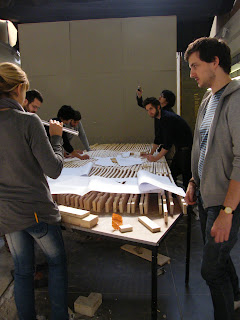
Tuesday, 27 October 2009
The High Tide
I have visited the site when the tide was high, and it was quite incredible how this environmental aspect has a great effect on the overall conception of our site. everything felt high as i walked around the O2 arena. its like, as the water line increases becoming higher all the surrounding objects seem to float with it. Below are some pictures:


Thursday, 22 October 2009
Patterns
 Clusters of box shapes.
Clusters of box shapes.

.jpg) Step 3: Coloring, Trying to find some repeated shapes to help me look at it in 3D as the next step is modeling the pattern.
Step 3: Coloring, Trying to find some repeated shapes to help me look at it in 3D as the next step is modeling the pattern..jpg)
.jpg) Step Two: moving intersecting points upwards and downwards.
Step Two: moving intersecting points upwards and downwards..jpg) Step One: Rotating the 2nd grid line by 10 degree angle to the left and the forth grid line by same angle but to the right continuously along the pattern.
Step One: Rotating the 2nd grid line by 10 degree angle to the left and the forth grid line by same angle but to the right continuously along the pattern..jpg) At this point i have decided to go back to the original pattern and experiment on it.
At this point i have decided to go back to the original pattern and experiment on it.
 Trial 2: Elimination and color addition, in this pattern i tried removing all the lines that are inside the big hex shapes and coloring the small ones.
Trial 2: Elimination and color addition, in this pattern i tried removing all the lines that are inside the big hex shapes and coloring the small ones. Trial 1: Distorting the pattern, i started looking at grid lines and thought of ways in changing them to create a totally new distorted pattern. I have moved every 2nd grid line from right to left on top of the one adjacent.
Trial 1: Distorting the pattern, i started looking at grid lines and thought of ways in changing them to create a totally new distorted pattern. I have moved every 2nd grid line from right to left on top of the one adjacent. Developing the pattern below, by making it more random where the small shapes interconnect with the middle and big shaped hexagon. it was created by surrounding the medium sized one with small hex and the Big sized ones surrounded by medium ones.
Developing the pattern below, by making it more random where the small shapes interconnect with the middle and big shaped hexagon. it was created by surrounding the medium sized one with small hex and the Big sized ones surrounded by medium ones.Size Variation: I have created this pattern by arranging the bigger box shapes in the centre and making them smaller as they move away from the centre. each variation in size is rescaled by half.

Seeing the Pattern as 6 diamond shapes that create a flower, i have changed the rule by reducing the number of diamonds by half. 6 => 3
This pattern was created by taking the 5 different shapes, looking at them as different sized boxes and arranging them randomly by mostly considering that it starts with bigger shapes repeated on each raw by moving them a step backwards then at a certain point it shifts where the smaller sized boxes start moving forward.
Taking those 5 different sized hex an make them overlap: second raw goes a step backwards from the first and the third steps forward from the second... and so on

Creating a new pattern by changing the length size of the hexagonal shapes, as they start being small and enlarge in length as they repeat vertically upwards.
 Paper and String, 2002 by Rinzen
Paper and String, 2002 by RinzenThis pattern is based on repeating 4 different shapes in one raw, then that raw shifting one shape to the right creating a new raw below, then another raw is created by shifting the whole thing back to starting point (so one shape to the left)...etc.
 This pattern was quite exciting as I've realised that connecting the dots of a starting point of a radiation of lines on the pattern, different sized triangles start to appear.
This pattern was quite exciting as I've realised that connecting the dots of a starting point of a radiation of lines on the pattern, different sized triangles start to appear.schloss Balmoral 3 (balmoral Castle 3), 2001-2002 by Ekrem Yalcindag

This pattern appears to have hexagonal shapes overlaying the one adjacent by its 1/3rd, or might just be boxes repeated horizontally and moved a step backwards when repeated vertically.
This pattern has been generated by overlaying 3 different coloured dots that vary in size in different areas: the yellow layer seem to have bigger sized dots in the middle area of the pattern and they become smaller towards the edges. The blue layer on the other hand, has the smaller size dots in the middle and the bigger ones covering the rest of the pattern while finally, the red layer doesn't seem to vary much in size but maybe similar to the blue its small size dots tend to be concentrated in the middle area.
Marble Floor by Wim Delvoye
Model Making
The model is almost finished :) we've been sanding the timber bits, gluing the cut out building pieces and assembling.
Subscribe to:
Posts (Atom)






































